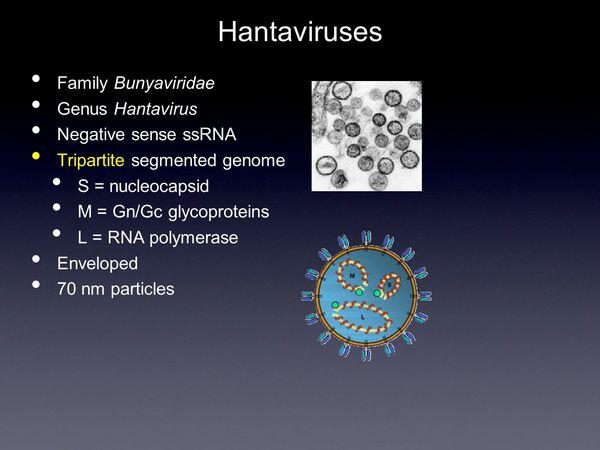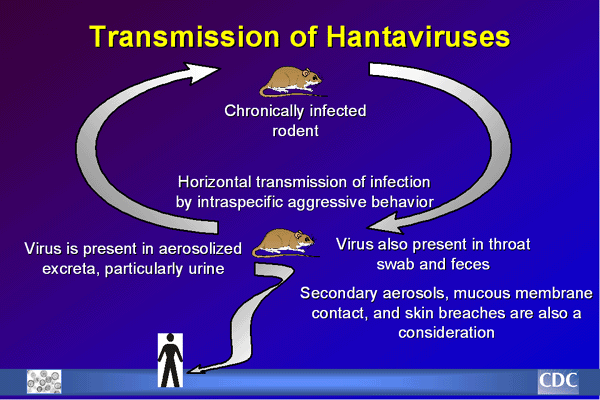Essentials of Diagnosis
- Acute severe respiratory infection in a young adult.
- Exposure to deer mice, eg, in a remote cabin.
- Occurrence of disease in far western United States, especially Four Corners states.
- Diagnosis by serology.
- Can detect viral RNA by PCR of respiratory samples.

General Considerations
Hantaviruses are members of the bunyavirus group, which is the largest family of viruses and contains several human pathogens including California encephalitis virus (see site). The hantavirus group was first recognized as causing hemorrhagic fevers with renal failure in Asia and Eastern Europe but became much more prominent in the United States when the hantavirus pulmonary syndrome was described in the United States.
Epidemiology
Unlike other bunyaviruses, which have an arthropod vector, hantaviruses spread from mammal to mammal, including humans, by exposure to aerosolized feces, infected urine, or other secretions.
Hantaviruses have been found throughout the world in a variety of rodents and other species. Most of these viruses are associated with hemorrhagic fever, with or without renal failure. In the United States, however, the most notable hantavirus is the Sin Nombre virus, which is associated with the severe pulmonary syndrome. This virus is found in 10-80% of deer mice in rural areas of North America. Spread of virus from rodents to humans is thought to result from intimate contact with the rodent habitat.
Microbiology
These viruses are spherical particles 80-120 nm in diameter. The envelope of the virus contains two glycoproteins and encloses three unique nucleocapsids. The nucleocapsids consist of three separate strands of RNA, the RNA-dependent RNA polymerase, and two nonstructural proteins.
Pathogenesis
In the hemorrhagic fever and hantavirus pulmonary syndromes, the primary lesion is leakage of plasma and erythrocytes through the vascular endothelium. In the former infection these changes are most prominent in the kidney and are accompanied by hemorrhagic necrosis of the kidney; in the latter the primary site of illness is the lung.
Clinical Findings
Signs and Symptoms
Hemorrhagic fevers are characterized by fever, petechial hemorrhages, ecchymoses, epistaxis, hematemesis, melena, and bleeding of gums. Death occurs in = 50% of cases with hemorrhagic phenomena.
Hantavirus pulmonary syndrome (HPS) begins with a prodrome of fever, headache, myalgia, and, often, gastrointestinal symptoms lasting approximately 4-5 days. This is followed by the onset of cough and dyspnea. Tachycardia and tachypnea are present, and hypotension may supervene. The respiratory status may progress to acute respiratory distress syndrome (ARDS) and respiratory failure in several hours. HPS should be especially suspected in healthy young individuals who rapidly develop febrile ARDS and who may have been exposed to rodents.
Laboratory Findings
There are no specific laboratory abnormalities, but hemoconcentration (due to vascular leak) leukocytosis, possibly with left shift, abnormal or increased lymphocytes, thrombocytopenia, or prolonged PTT are seen in the more severe cases. In addition, there is evidence of progressively worsening lung function.
Imaging
Bilateral, diffuse, interstitial pulmonary infiltrates evolve rapidly in patients with HPS.
Differential Diagnosis
Acute, severe pneumonia of multiple causes must be distinguished from HPS. In particular, pneumonia caused by influenza A virus, Legionella spp., Chlamydia pneumoniae, or Pneumocystis carinii may be similar, but the epidemiology, age of the patient, and other factors provide clues to the etiology.

Complications
The principal complication of hantavirus infection is the severe impairment of lung function.
Diagnosis
Culture
Virus may be recovered by inoculation of animals or by cell culture.
Direct detection
Hantavirus RNA can be detected by PCR in clinical specimens from patients with high levels of viremia.
Serology
IgM-specific assays are the main method to rapidly document acute infection. Seroconversion or a fourfold increase in IgG antibody is useful to document recent infection, but cross-reactions within viral genera are common.
Treatment
Ribavirin has been used to treat hantavirus pulmonary syndrome, but its efficacy is not established. Supportive therapy of ARDS is critical to survival.
Prognosis
HPS is fatal in approximately 50% of those who develop clinical illness.

Prevention & Control
Human disease is prevented by interrupting the contact between humans and rodents. Rodent control also minimizes transmission.


